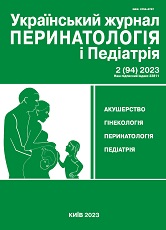Comparative analysis of the prevalence and structure of night sleep disorders in children with neurodevelopmental disorders in wartime and peacetime
DOI:
https://doi.org/10.15574/PP.2023.94.77Keywords:
children, neurodevelopmental disorders, sleep disorders, autism spectrum disorders, epilepsy, developmental delay, tics, attention deficit hyperactivity disorder, insomnia, parasomnia, hypersomnia, sleep apnoeaAbstract
The problem of sleep disorders in children is one of the most urgent in the practice of a pediatrician and has become especially acute during wartime, given the chronic effects of a significant number of stressors. The need to develop practical recommendations for improving the quality of sleep in children during wartime necessitated a comparative study of the frequency and structure of sleep disorders in children during wartime and peacetime.
Purpose - to determine the frequency and structure of nighttime sleep disorders in children with neurodevelopmental disorders and healthy children in wartime and peacetime.
Materials and methods. An online survey of parents of 529 children aged 1-7 years (26.8% of healthy children and 73.2% of children with neurodevelopmental disorders) was conducted in 2022 during wartime. A survey of parents of 1352 children under the age of 7 was conducted in 2002 in peacetime (as part of the Family and Children of Ukraine project), with a case-control comparison.
Results. The overall prevalence of nighttime sleep disorders among all children in wartime was 93.6% in healthy children and 94.8% in children with neurodevelopmental disorders. Difficulties falling asleep were noted in 51.4% of healthy children and 56.8% of children with neurodevelopmental disorders; frequent nighttime awakenings - in 35.9% and 39.0% of children, respectively. Sleep disorders: snoring - in 16.2% and 18.9% of children; apnoea - in 9.9% and 14.9% of children. Parasomnias: night terrors - in 19.7% and 18.6% of children; sleepwalking - in 2.8% and 4.4% of children.
Comparison of the frequency of nighttime sleep disorders in healthy children in peacetime (2002) and wartime (2022): half of healthy children had difficulty going to bed (51.4% vs. 47.2%); early waking (49.8% vs. 12.7%); frequent waking at night (47.3% vs. 35.9%); snoring (33.6% vs. 16.2%); increased daytime sleepiness - 5 times more often in 2002 (30.3% vs. 6.3%); every fourth child has nightmares (25.6% vs. 26.8%); prolonged falling asleep (23.5% vs. 51.4% in 2022).
Conclusions. The overall prevalence of nighttime sleep disorders among all children in wartime was 94.5%. In children with neurodevelopmental disorders, early awakenings (29.2% vs. 12.7%), sleep apnoea (14.9% vs. 9.9%), increased daytime sleepiness (14.9% vs. 6.3%), and catalepsy (8.3% vs. 4.2%) were more common compared to healthy children.
In wartime, the incidence of early wake-ups (49.8% vs. 12.7% in 2022), snoring (33.6% vs. 16.2% in 2022), and increased daytime sleepiness (30.3% vs. 6.3% in 2022) decreased among healthy children, but the incidence of falling asleep problems increased by 2 times (51.4% vs. 23.5% in the 2002).
Children with neurodevelopmental disorders are a more vulnerable group that reacts negatively to the stressful conditions of martial law by increasing the frequency of nighttime sleep disorders.
The research was carried out in accordance with the principles of the Helsinki Declaration. The study protocol was approved by the Local Ethics Committee of all participating institutions. The informed consent of the patient was obtained for conducting the studies.
References
American Psychiatric Association. (2013). Diagnostic and Statistical Manual of Mental Disorders. 5th Edition (DSM-5). Washington, DC: American Psychiatric Association. https://doi.org/10.1176/appi.books.9780890425596
Irwanto, Rehatta NM, Hartini S, Takada S. (2016). Sleep Problem of Children with Autistic Spectrum Disorder Assessed by Children Sleep Habits Questionnaire-Abbreviated in Indonesia and Japan. The Kobe journal of medical sciences. 62 (2): E22-E26.
Kyrylova LG, Miroshnykov OO. (2022). Klinichna otsinka efektyvnosti neiroprotektornoi terapii v ditei z porushenniamy movlennievoho y kohnityvnoho rozvytku. International neurological journal. 18: 17-23. https://doi.org/10.22141/2224-0713.18.4.2022.954
Kyrylova LH ta in. (2012). Hipersomnii u ditei: narkolepsiia ta syndrom Kleina- Levina-Krichli. Ukr. med. almanakh. 15 (4): 69-74.
Kyrylova LH, Miroshnykov OO, Yuzva OO, Berehela OV. (2021). Naibilsh poshyreni rozlady snu u ditei ta pidkhody do yikhfarmakolohichnoi ta nefarmakolohichnoi korektsii. «Zdorovia dytyny». 16: 1. http://www.mif-ua.com/archive/article/50345.
Kyrylova LH, Miroshnykov OO, Yuzva OO. (2022). Paroksyzmalni rozlady snu v ditei z epileptychnymy entsefalopatiiamy ta rozladamy autystychnoho spektra. Suchasna pediatriia. Ukraina. 5 (125): 76-83. https://doi.org/10.15574/SP.2022.125.76
Kyrylova LH. (2020). Dyferentsialna diahnostyka syndromu rannoi dytiachoi nervovosti u praktytsi pediatra. Zdorovia dytyny. 15 (5): 24-32.
Leung A, Leung A, Wong A, Hon KL. (2020). Sleep Terrors: An Updated Review. Current pediatricreviews. 16 (3): 176-182. https://doi.org/10.2174/1573396315666191014152136; PMid:31612833 PMCid:PMC8193803
Morris-Rosendahl DJ, Crocq MA. (2020). Neurodevelopmental disorders - the history and future of a diagnostic concept. Dialogues in clinical neuroscience. 22 (1): 65-72. https://doi.org/10.31887/DCNS.2020.22.1/macrocq; PMid:32699506 PMCid:PMC7365295
Robinson-Shelton A, Malow BA. (2016, Jan). Sleep Disturbances in Neurodevelopmental Disorders. Curr Psychiatry Rep. 18 (1): 6. https://doi.org/10.1007/s11920-015-0638-1; PMid:26719309
Sabariego-Navarro M, Fernández-Blanco A, Sierra C, Dierssen M. (2022). Neurodevelopmental disorders: 2022 update. Free Neuropathology. 3: 8. https://doi.org/10.17879/freeneuropathology-2022-3801.
Sateia MJ. (2014). International classification of sleep disorders-third edition: highlights and modifications. Chest. 146 (5): 1387-1394. https://doi.org/10.1378/chest.14-0970; PMid:25367475
Downloads
Published
Issue
Section
License
Copyright (c) 2023 Ukrainian Journal of Perinatology and Pediatrics

This work is licensed under a Creative Commons Attribution-NonCommercial 4.0 International License.
The policy of the Journal “Ukrainian Journal of Perinatology and Pediatrics” is compatible with the vast majority of funders' of open access and self-archiving policies. The journal provides immediate open access route being convinced that everyone – not only scientists - can benefit from research results, and publishes articles exclusively under open access distribution, with a Creative Commons Attribution-Noncommercial 4.0 international license(СС BY-NC).
Authors transfer the copyright to the Journal “MODERN PEDIATRICS. UKRAINE” when the manuscript is accepted for publication. Authors declare that this manuscript has not been published nor is under simultaneous consideration for publication elsewhere. After publication, the articles become freely available on-line to the public.
Readers have the right to use, distribute, and reproduce articles in any medium, provided the articles and the journal are properly cited.
The use of published materials for commercial purposes is strongly prohibited.

